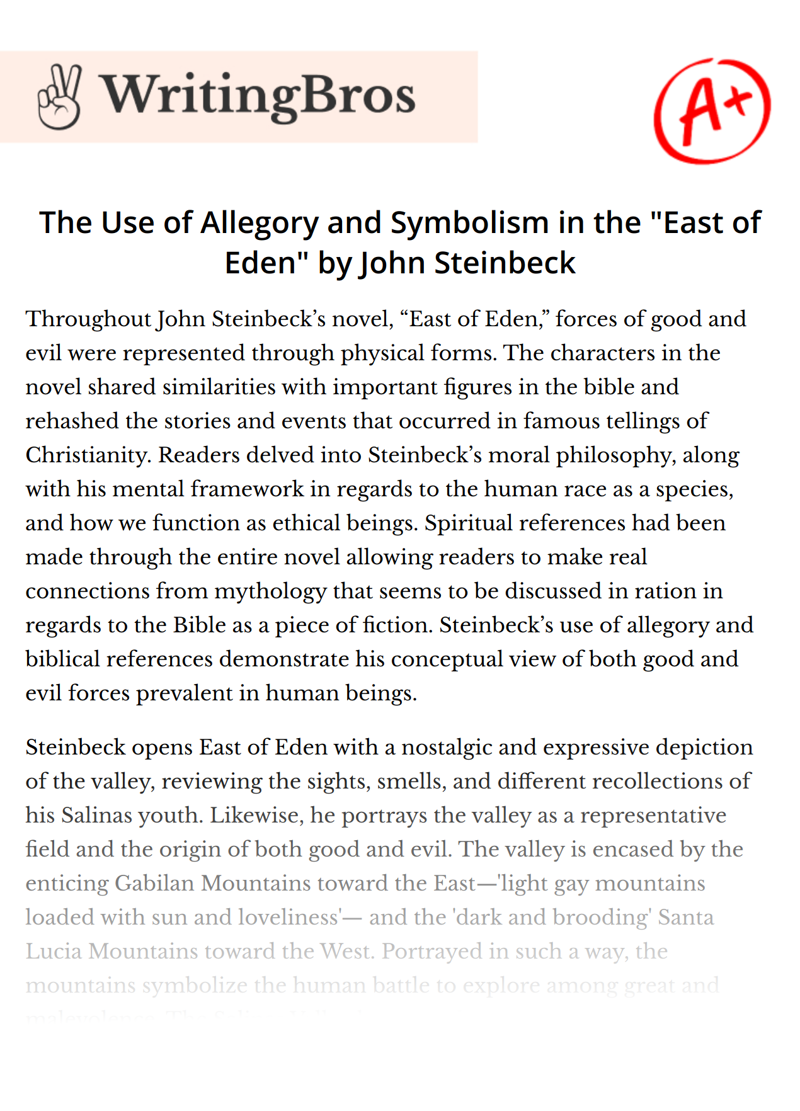The Use of Allegory and Symbolism in the "East of Eden" by John Steinbeck
 Read Review
Read Review

Throughout John Steinbeck’s novel, “East of Eden,” forces of good and evil were represented through physical forms. The characters in the novel shared similarities with important figures in the bible and rehashed the stories and events that occurred in famous tellings of Christianity. Readers delved into Steinbeck’s moral philosophy, along with his mental framework in regards to the human race as a species, and how we function as ethical beings. Spiritual references had been made through the entire novel allowing readers to make real connections from mythology that seems to be discussed in ration in regards to the Bible as a piece of fiction. Steinbeck’s use of allegory and biblical references demonstrate his conceptual view of both good and evil forces prevalent in human beings.
Steinbeck opens East of Eden with a nostalgic and expressive depiction of the valley, reviewing the sights, smells, and different recollections of his Salinas youth. Likewise, he portrays the valley as a representative field and the origin of both good and evil. The valley is encased by the enticing Gabilan Mountains toward the East—'light gay mountains loaded with sun and loveliness'— and the 'dark and brooding' Santa Lucia Mountains toward the West. Portrayed in such a way, the mountains symbolize the human battle to explore among great and malevolence. The Salinas Valley between them can be viewed as a portrayal of the grounds where the scriptural Adam and Eve live after God expels them from Eden. Subsequent to being driven from Eden, Adam and Eve are compelled to live in a world in which the risks and enticements of malice are present. In like manner, the principle characters in, “East of Eden,” battle to exercise through and through freedom even with the acquired wrongs of their precursors.
When viewed through a spiritually driven perspective, readers tie the allegory and symbolic references used by Steinbeck that further exemplify his ideals pertaining to forces that are beyond our belief and understanding of humankind and the way the mind works, yet still remain in action in all walks of life. For instance, one of these ideas presents itself in the text by Lee as he says, “Don’t you see?... The American Standard translation orders men to triumph over sin, and you call sin ignorance. The King James translation makes a promise in ‘Thou shalt,’ meaning that men will surely triumph over sin. But the Hebrew word, the word timshel—‘Thou mayest’—that gives a choice. It might be the most important word in the world. That says the way is open.” Lee says these words during his exchange of the Cain and Abel story with Samuel and Adam in Chapter 24. He has quite recently uncovered to different men the result of the examination he did on the importance of timshel, the word that God articulates to Cain when banishing him to the terrains east of Eden. As indicated by one interpretation of the Bible, God orders Cain to triumph over transgression, while as per another, God guarantees Cain that he will be beating sin. Lee's examination, in any case, has uncovered that timshel signifies 'thou mayest,' suggesting that God discloses to Cain that he has a decision whether to defeat sin. Lee sees this thought of free decision over underhandedness a token of idealism that is integral to the human condition. He endeavors to persuade Adam and Cal of the legitimacy of timshel and eventually succeeds, as Adam gives Cal his approval and Cal acknowledges he himself has the ability to beat his family's heritage of insidiousness.
Cite this Essay
To export a reference to this article please select a referencing style below




